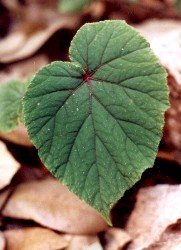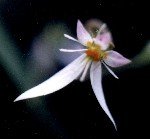Perennial Begonias
by Valerie (November 1, 2002)
 Usually thought of as house plants or annuals, there is a type of perennial begonia. Hardy begonia (Begonia grandis or ssp. evansiana) grows from a tuberous root and can withstand mild freezes. I was surprised to find a "perennial" begonia at a nursery and decided to try one. It is planted in a shady area under a large live oak tree. While the plant definitely comes up every year, it is not all that successful. It has never had more than three leaves at a time or grown over five inches tall. It has also never bloomed. The hottest part of summer usually signals the end of its growing season, whereupon it withers and dies back. The next spring, it comes up on a thick stem, as healthy as it ever gets. Perhaps it does not get enough water or the heat is too much, but it is heartening to see it try to grow every spring. One year the first stem with one leaf was eaten off by slugs and it didn't grow the rest of the summer, but it usually lasts until the end of June. This past summer was its best season yet, due to almost constant rain for several weeks and lower than normal temperatures. The plant produced three leaves, which is its record so far. Maybe it will one day produce the pretty pink blossoms that I've seen in pictures.
Usually thought of as house plants or annuals, there is a type of perennial begonia. Hardy begonia (Begonia grandis or ssp. evansiana) grows from a tuberous root and can withstand mild freezes. I was surprised to find a "perennial" begonia at a nursery and decided to try one. It is planted in a shady area under a large live oak tree. While the plant definitely comes up every year, it is not all that successful. It has never had more than three leaves at a time or grown over five inches tall. It has also never bloomed. The hottest part of summer usually signals the end of its growing season, whereupon it withers and dies back. The next spring, it comes up on a thick stem, as healthy as it ever gets. Perhaps it does not get enough water or the heat is too much, but it is heartening to see it try to grow every spring. One year the first stem with one leaf was eaten off by slugs and it didn't grow the rest of the summer, but it usually lasts until the end of June. This past summer was its best season yet, due to almost constant rain for several weeks and lower than normal temperatures. The plant produced three leaves, which is its record so far. Maybe it will one day produce the pretty pink blossoms that I've seen in pictures.

The other perennial is called a strawberry begonia (Saxifraga stolonifera or S. sarmentosa) or strawberry geranium. It is not a strawberry, begonia, or geranium. However, it is a very interesting little plant and has survived for about 6 or 7 years in one place in the gardens. The strawberry begonia has thick, scalloped, round leaves, with beautiful silver veins atop red stems. The leaves are quite hairy. As the Latin name would imply, the plant produces stolons from which sprout new plants. Another, less commonly used, name for this plant is mother-of-thousands. This seems to be a favorite name for any plant that produces numerous baby plants.
Our strawberry begonias have blossomed, although they don't do it every year. The flowers are tiny, pale pink, and very interesting. They grow at the end of long, thin stems and seem to hover in midair above the leaves. Two of the five petals are longer than the others.
The plants do well if they get enough water and are protected from the sun. We also have them growing close to the foundation of the house so they are protected a bit from extremes of temperature. Although they reproduce quickly, they cannot tolerate being overgrown by other plants, or even being covered by leaves. Because they are so low-growing, they can quickly be lost under larger leaved plants. They seem to need bare dirt in order to root, so I always clear an area around them. In spite of extra care, the individual plants often remain extremely small. |
